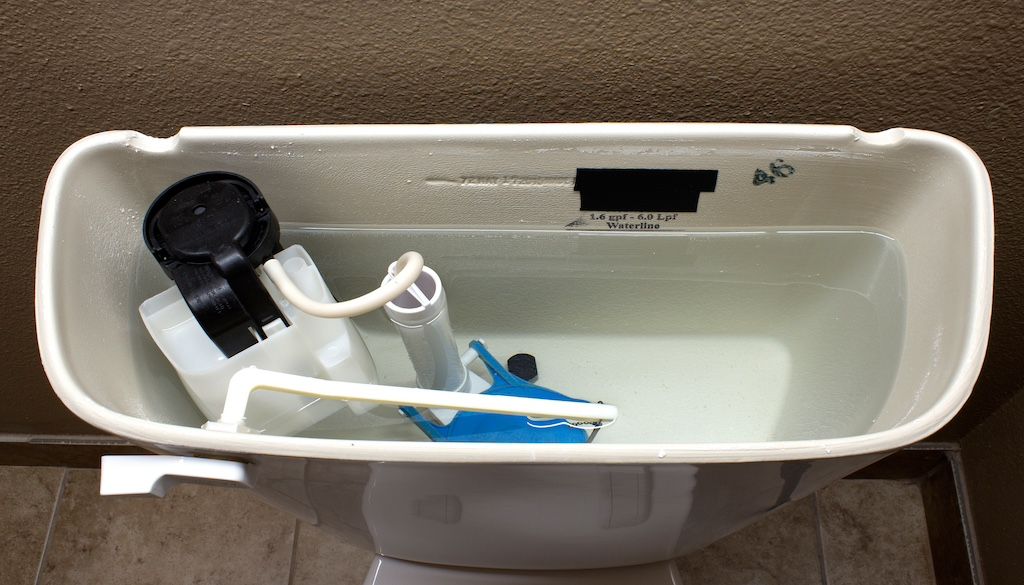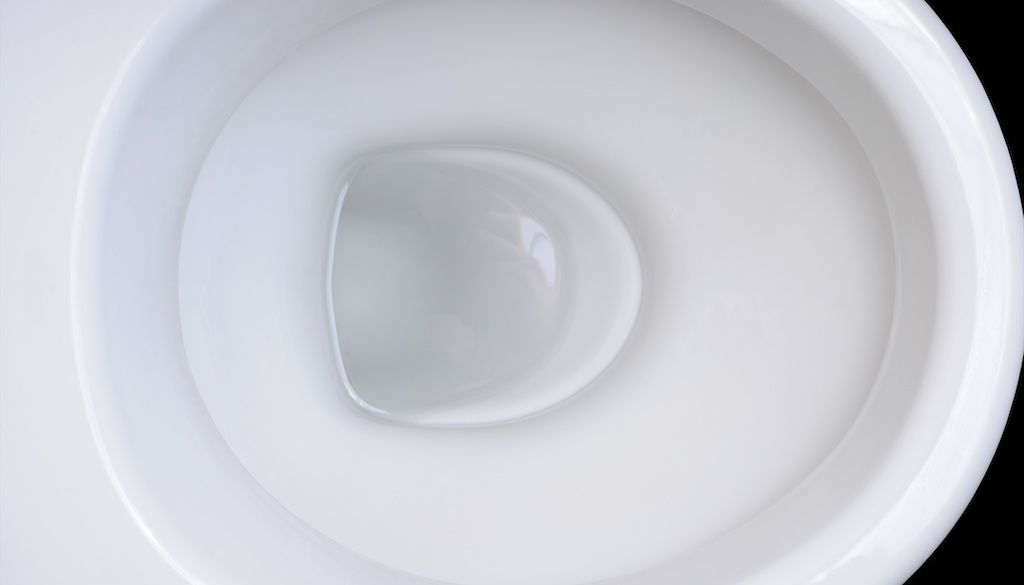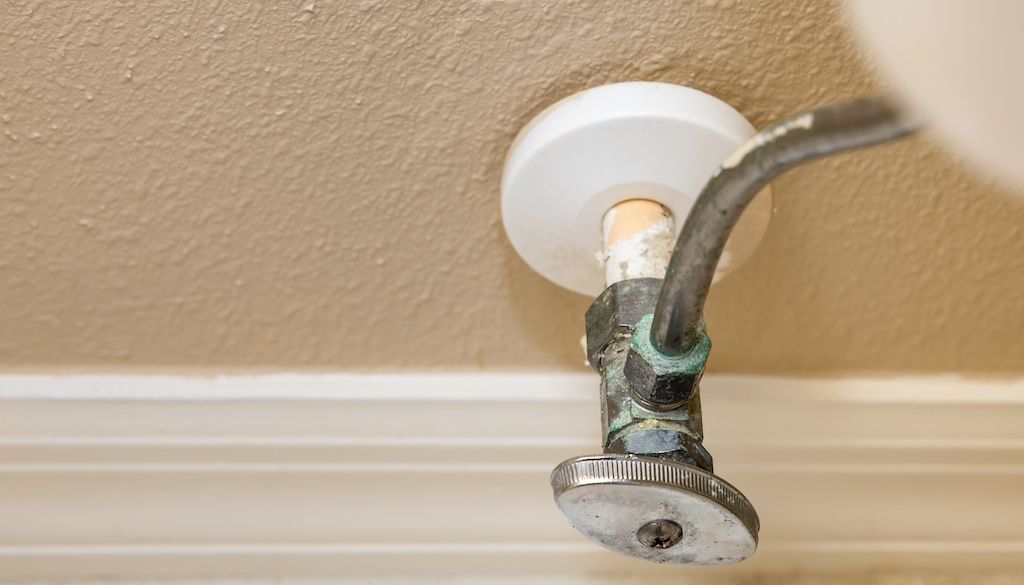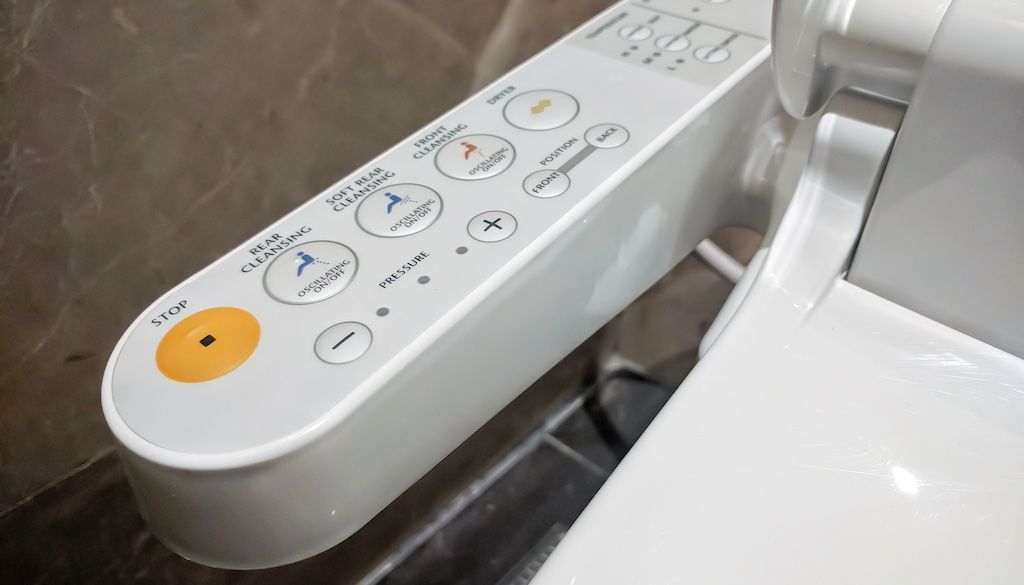The key components of a toilet tank.
 First, let’s look at the toilet tank parts that allow it to flush:
First, let’s look at the toilet tank parts that allow it to flush:
Fill valve: Regulates water flow and level.
Your toilet fill valve is responsible for refilling your toilet tank. It’s the tall, cylindrical component, typically toward the left side of the tank. When you flush the toilet, the fill valve opens to refill the tank. A properly working fill valve prevents overflow and ensures your toilet flushes correctly.
Float or ballcock: Also helps with water levels.
A toilet float also helps regulate the water level inside the tank. It's typically a buoyant device or ball that floats on the surface of the water in the tank. The float is connected to the fill valve, which controls the flow of water into the tank from the water supply line.
Flush valve: Triggers the flushing mechanism.
While the fill valve allows water to flow into the tank, the flush valve allows water to flow out of the tank. When you press your toilet's flush handle, the flush valve provides a path from the tank to the bowl.
Overflow tube: Prevents water from overflowing.
A key component of the flush valve is the overflow tube, which prevents toilet tank water from overflowing and spilling onto your floor. It provides a path for excess water to flow into the toilet bowl.
The height of the overflow tube determines the maximum water level in the toilet tank. Most overflow tubes are positioned at a height that corresponds to the desired fill level for the tank, ensuring that the tank doesn't overfill during the refill process.
Flapper: Seals and prevents leaks.
The toilet flapper is the rubber, plunger-like mechanism at the bottom of the tank. The flapper is usually connected to the flush handle with a chain. Pressing the flush handle lifts the flapper, allowing water to flow into the toilet bowl.
To prevent your toilet from running or leaking, the flapper has to have a perfect seal. The weight of the water in the tank keeps the flapper pushed down.
Gasket or O-ring seal: Creates a seal between the tank and bowl.
The term "toilet gasket" or "O-ring seal" typically refers to the toilet tank-to-bowl gasket or the tank-to-bowl seal. This gasket is a crucial component that forms a watertight seal between the toilet tank and the toilet bowl to prevent leaks.
Over time, these gaskets may degrade due to wear and tear, leading to leaks or inefficiencies in toilet operation. Replacing a worn or damaged toilet gasket is a common maintenance task to ensure the proper functioning and water efficiency of the toilet.
Find a top-rated plumber near you.
Please enter a valid zip code
Exploring the components of a toilet bowl.
 Now that we’ve examined the moving pieces, here are the stationary parts of your toilet bowl.
Now that we’ve examined the moving pieces, here are the stationary parts of your toilet bowl.
Trapway: Waste disposal.
The trapway of your toilet is the tube that carries waste and flushed water from your bowl. The trapway is usually S-shaped to keep a small amount of water trapped in the curve. This water prevents sewage gas from coming out of the toilet.
Rim jets: Where the water enters the bowl.
Under the lip of your toilet bowl are small rim jets or holes that dispense water when you flush the toilet. Over time, rim holes can sometimes become clogged or obstructed with rust or other debris. Cleaning the rim holes periodically can prevent flushing problems.
Wax ring: Seals the toilet to the floor.
Between the base of your toilet and the floor, a thin wax seal prevents water leaks and mold growth. If you remove the toilet for any reason (to repair or replace it), you’ll need to replace the wax ring, which sits on your toilet flange.
Understanding the exterior plumbing parts of a toilet.
 There are also a few parts on the outside of your toilet that are essential for it to work properly.
There are also a few parts on the outside of your toilet that are essential for it to work properly.
Toilet floor flange: Connects to the drainage system.
A toilet flange or toilet floor flange's primary function is to securely connect the toilet bowl to the waste pipe below the floor level.
The flange is typically attached to the floor and provides a stable base for the toilet to sit on. It also has a hole in the center through which the waste pipe passes. This aligns the toilet's outlet with the waste pipe, allowing waste to be efficiently flushed away.
Water supply line: Connects water to the toilet.
Without a steady stream of water, your toilet won't refill after flushing. The water supply line connects your toilet to the water main. This connection usually has a shut-off valve attached.
Shut-off valve: Cuts off water flow.
On your water supply line, there should be a small valve you can tighten or loosen. This is the shut-off valve. Tightening this valve allows you to disconnect the water supply to your toilet without shutting off water to your entire home. If your toilet isn’t flushing, the first thing you should check is the shut-off valve.
Flush handle: Initiates the flush.
This piece of hardware should be familiar to homeowners. The flush handle is the small lever you press to flush the toilet. Although it’s a simple mechanism, the toilet handle plays an important role in your toilet’s efficiency.
When you press the flush handle, it lifts an arm connected by a chain to the flapper. A problem with the handle can lead to small water leaks that can waste water over time.
Get free estimates from top-rated plumbers.
Please enter a valid zip code
Maintaining and repairing toilet parts.
Keeping your toilet in working condition is usually a small DIY project. For bigger repairs, you may want to hire a plumber.
Troubleshooting common toilet issues.
For basic toilet problems, you can perform the following simple tests:
- Flush the toilet to see if it takes too long or runs without stopping.
- Place some food coloring into the tank to check for leaks (the water in the bowl will change color if there is a leak).
- Gently try to rock the toilet side to side to test the seal to the floor.
A running toilet can indicate a worn part in the tank, creating an imperfect seal. Leaks and running toilets can waste water and increase your water bill.
How to replace faulty toilet parts.
Most minor toilet issues are easy enough to fix on your own, but if you can’t identify the problem, you may need to hire a pro.
If you need to replace a part you can identify in your toilet, take the following measures:
- Identify the faulty part (common part failures include flappers and float balls).
- Turn off the water supply valve.
- Flush the toilet to empty the tank.
- Remove the tank lid.
- Remove the worn part.
- Install the replacement part.
- Replace the tank lid and turn the water supply back on.
Tools and supplies needed for toilet repairs.
Often, small toilet issues are fixable by hand. The exact tools you’ll need depend on the nature of the repair. However, some common items a DIY plumber should have on hand include:
- Toilet replacement parts (new flapper valve, fill valve, and wax ring)
- Putty knife
- Adjustable wrench
- Pliers
- Screwdriver
- Toilet auger for unclogging
- Hand towel (to clean up spills)
Compare prices from plumbers near you.
Please enter a valid zip code
Toilet features for comfort and functionality.
 Homeowners wanting to upgrade their toilets have plenty of modern features to choose from. For example:
Homeowners wanting to upgrade their toilets have plenty of modern features to choose from. For example:
- Modern designs. Opt for a sleek, low-profile design to complement a modern bathroom.
- Dual-flush systems. Save water with a dual-flushing mechanism. These systems allow you to choose between a partial flush for liquid waste and a full flush for solid waste.
- Enhanced toilet seat options. Explore heated seats, soft-close eats, and even built-in bidet attachments. You can also consider switching to a different material, like plastic, wood, and cushioned seats for extra comfort.
Explore new toilet parts and features offered by your favorite brands and manufacturers. If you need help installing the new toilet or part, hire a pro near you.
Find pros to replace or repair the parts of your toilet.
The next time you experience an issue with your toilet parts, consider enlisting the help of a professional. A plumber can help you diagnose and fix many toilet issues. Just give them details about your toilet problem, request a free quote, and schedule a consultation or an appointment.
Begin your search for the best plumber on Thumbtack. Download the app today so you can see a list of top-rated pros in your area.
FAQs
What is the part of the toilet that goes into the floor?
The toilet flange is the part that goes into the floor. The wax ring creates a seal between the flange and the toilet base that prevents water from leaking out of the bottom of the toilet.
What are the two main parts inside the tank of a toilet?
The two main components in the toilet tank are the fill valve and flush valve. The fill valve fills the tank with water, while the flush valve allows water to flow into the bowl from the tank.